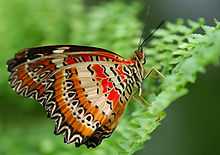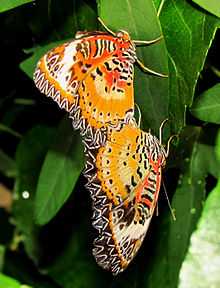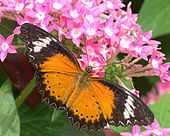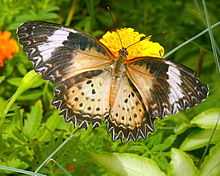Cethosia cyane
| Leopard Lacewing | |
|---|---|
 | |
| male, underside | |
 | |
| coupling | |
| Scientific classification | |
| Kingdom: | Animalia |
| Phylum: | Arthropoda |
| Class: | Insecta |
| Order: | Lepidoptera |
| Family: | Nymphalidae |
| Genus: | Cethosia |
| Species: | C. cyane |
| Binomial name | |
| Cethosia cyane (Drury, 1773) | |
| Subspecies | |
| |
The Leopard Lacewing (Cethosia cyane) is a species of heliconiine butterfly found from India to southern China (southern Yunnan), and Indochina. Its range has expanded in the last few decades, and its arrival in the southern part of the Malay Peninsula, including Singapore, is relatively recent.
Description
- See also Glossary of Lepidopteran terms

Male
Upperside tawny, in fresh specimens a rich reddish tawny. Fore wing: anterior and apical two-thirds black, the margin of this colour waved and irregular, following a line dividing the cell longitudinally and circling round to near the posterior angle; a short, broad, oblique, white-bar beyond apex of cell, the veins crossing it and a spot in interspaces 3 and 4 black; a transverse indistinct row of small spots and a terminal series of <-shaped lunules white. Hind wing: three or four spots just beyond apex of cell, a subterminal row of spots and the termen broadly black, the last with a series of white lunules as on the fore wing. Underside variegated with red, white, pale blue, ochraceous and black; the terminal margins of both wings broadly black with white lunules as on the upperside; in the middle of each lunule a short white streak from the margin; cilia alternately black and white. Fore wing: the cell with transverse bands of red, blue and black; the base and disc below the cell red spotted with black, followed by pale blue, ochraceous and black; the white oblique band as on upperside, beyond it a transverse incomplete row of lanceolate white marks, with three black spots in each, followed by a subterminal ochraceous band paling inwardly. Hind wing: the base and cell pale blue and red, crossed by several broken incomplete black lines, then alternate bands of white and ochraceous, two of each; the outer white band narrow and marked in each interspace with three black spots arranged as a triangle. Antennae, head and thorax dusky brown; abdomen above tawny, beneath white.[1]

Female
Similar to the male in markings, but the tawny groundcolour replaced by pale greenish white, somewhat brownish on the upperside of fore wing, the extent of black on this wing larger. Underside with all the markings paler than in the male the red at the base of the wings replaced by brownish yellow on the fore, white on the hind wing. Antennae, head and thorax dusky brown; abdomen dusky above, white beneath.[1]
Larva
"Cylindrical, purplish-black segments with alternate yellow and crimson bands. Head armed with two long spines, segments with dorsal and lateral rows of fine spines. Feeds on Passiflora, July. (Described from drawing by Major C. H. E. Adamson.)." (Frederic Moore)
References
External links
![]() Media related to Cethosia cyane at Wikimedia Commons
Media related to Cethosia cyane at Wikimedia Commons
![]() Data related to Cethosia at Wikispecies
Data related to Cethosia at Wikispecies